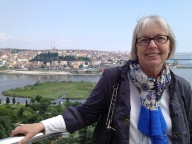The Media Management & Economics Division, along with the Electronic News Division, is hosting a theme session on news engagement at the AEJMC conference in Montreal. We are showcasing the session, titled “Engaging the Audience: How News Organizations Are Coming Out of the Newsroom and Finding New Ways to Connect,” In this post the featured panelist is Nancy Benson.

Nancy Benson is an associate professor of journalism in the Department of Journalism at the University of Illinois and was recently named to the Fulbright Specialist roster. She is an award winning broadcast journalist, former Knight Fellow in Eastern Europe and a former Benton Fellow at the University of Chicago. Benson joined the Department of Journalism at Illinois following a twenty-five year career in radio and television news. She has trained journalists in developing countries in nearly every region of the world and is committed to creating a new generation of journalists with a global perspective. Benson has been taking journalism students on reporting expeditions to foreign lands since 2005.
Q: Your class, Rural Multimedia Reporting, is conducting an immersive experience in which the students are stationed in a small town and engage the community members in a variety of ways to learn about what’s important to them. How has it gone?
This is a second eight weeks course, so we’re still building our head of steam. We have a one-week immersion experience planned where we’ll live in the town 24/7. We have made two visits to the town during class time and students are already connecting with townspeople and identifying the important issues to the community. Our website is nearly built and on it we have a section titled “voices” where we will feature the voices of community members to talk about their memories of this once-bustling town and their views about the future of the town. We are talking with a cross section of community members from the elderly to high school students and younger and reaching out to the minority population the census shows exists, but has been invisible on our visits.
Q: How has this project helped inform your students about news engagement in this town?
The students are learning to do better face-to-face interviews and the biggest challenge is earning the trust of community members who fear the stories will be negative and the community won’t be well represented. They are learning how to counteract this view, without making promises of doing only upbeat stories that might not best reflect the economic conditions. They are also learning how to navigate the various factions within this small town with differing views on the potential for the town to “come back.”
Q: How can projects like this help news organizations? How can they do something similar?
We are digging deeper and spending lots of time talking to a wide range of people, rather than dropping in on the town to cover just one issue. We are taking the time to really ascertain what the community sees as problems/issues/positive attributes and possible solutions as the town struggles to figure out how to attract new business. By digging deeply into one small town we are learning about the struggles in more depth that are relevant in many small towns across the country suffering decline.
Q: What’s something unexpected your students have learned from this project?
How open people are in a small town. They’re used to working against resistance from city officials and community members on stories they do in a more urban setting. Here, they find everyone is helpful. Of course, that could change when we settle in for a weeklong, deeper engagement.
